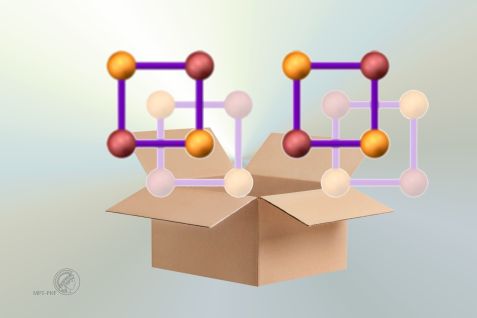MLZ is a cooperation between:
 > Technische Universität München
> Technische Universität München > Helmholtz-Zentrum Hereon
> Helmholtz-Zentrum Hereon
 > Forschungszentrum Jülich
> Forschungszentrum Jülich
MLZ is a member of:
 > LENS
> LENS > ERF-AISBL
> ERF-AISBL
MLZ on social media:

MLZ (eng)
Lichtenbergstr.1
85748 Garching
05.11.2021
Neutrons unravel 50-year-old physics mystery

Neutron measurements bring the hidden order out of the box after 50 years: Within a layer, the iron atoms in Sr3Fe2O7 are arranged in a chequerboard pattern. However, the stacking of the layers is random. © Max Planck Institut für Festkörperforschung, Stuttgart, Deutschland.
More than 50 years ago, researchers discovered a pronounced phase transition in strontium iron oxide at room temperature. However, what exactly happens in this process at the atomic level has been unclear ever since. Using high-resolution neutron measurements, a research team from the Max Planck Institute for Solid State Research at the Heinz Maier-Leibnitz Center (MLZ) has now been able to solve this old mystery.
Phase transitions in solids are phenomena in which order emerges from disorder. Macroscopically, they show up through anomalies, such as the sharp increase in magnetism or the sudden drop in resistance. In strontium iron oxide (Sr3Fe2O7), which the scientists studied in more detail, the phase transition was evident in the thermal properties: the specific heat suddenly changes upon cooling.
Mössbauer spectroscopy identified this phase transition 50 years ago. “But we wanted to understand what happens in the process at the atomic level. Up until now, we simply haven’t found anything,” explains Dr. Thomas Keller, instrument scientist at the TRISP three-axis spin spectrometer at MLZ. Researchers therefore called the phenomenon “hidden charge order.”

Dr Thomas Keller's team carried out the high-resolution measurements on the TRISP three axes spectrometer. © Bernhard Ludewig / FRM II, TUM
The solution is in the checkerboard pattern
“In very simple terms, the iron atoms are normally arranged on a square lattice. These, in turn, are stacked in layers,” said Keller, who works at MLZ through the cooperation partner Max Planck Institute for Solid State Research under the direction of Prof. Bernhard Keimer. In the individual square layers, the two valence states of the iron produce a simple checkerboard pattern. However, the stacking of the successive layers is random.
“At TRISP, we have very high-resolution Larmor diffraction, which is not possible anywhere else,” Keller explains. “This allowed us to measure the spacing of atoms and see that they were minimally distorted by charge.” The research team combined the Larmor diffraction with a high-resolution X-ray measurements at the German Electron Synchrotron DESY, which made the stacking visible. “It was only by combining this with the second method that we were even believed to have actually solved the hidden charge puzzle,” Keller said.
New concepts for data storage possible
“Of course, we are doing pure basic research; Sr3Fe2O7 is a well-known model substance,” Keller explains. “However, further technical development always stands or falls with the available materials. This has been the case since the Stone Age,” he continues. It is therefore important to gain the greatest possible understanding of these types of materials.
Sr3Fe2O7, for example, is a candidate for a new type of data memory called “phase change memory” (PCM). If it were possible to manipulate the randomly stacked “checkerboards” of the individual layers in a targeted manner, i.e. to bring the stacking into an order, two “ordered” and “disordered” types of states would result. This can easily be transferred into the data bits 0 and 1. A small distortion on the atomic level might therefore have a bigger future significance.
Original publication:
J.-H. Kim, D. C. Peets, M. Reehuis, P. Adler, A. Maljuk, T. Ritschel, M. C. Allison, J. Geck, J. R. L. Mardegan, P. J. Bereciarua Perez, S. Francousal, A. C. Walters, T. Keller, P. M. Abdala, P. Pattinson, P. Dosanjh, Keimer, B. Hidden Charge Order in an Iron Oxide Square-Lattice Compound. Phys Rev Lett., 9, 127 (2021) – DOI: https://doi.org/10.1103/PhysRevLett.127.097203
Source and further information:
https://www.fkf.mpg.de/7518900/2021_09_Keimer
MLZ is a cooperation between:
 > Technische Universität München
> Technische Universität München > Helmholtz-Zentrum Hereon
> Helmholtz-Zentrum Hereon
 > Forschungszentrum Jülich
> Forschungszentrum Jülich
MLZ is a member of:
 > LENS
> LENS > ERF-AISBL
> ERF-AISBL
MLZ on social media:


